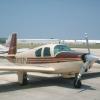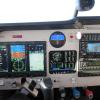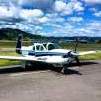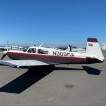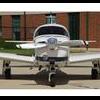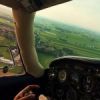Leaderboard
Popular Content
Showing content with the highest reputation on 02/02/2025 in all areas
-
After landing I put the flap switch in up position and the flaps did not move and the circuit breaker popped. Thereafter, I noted that the breaker would pop when the master was turned on with the flap switch in up, takeoff, or down position (the airplane is a later model with the three position flap switch). I tried wiggling the flaps because some have said that got them working again, but to no avail. I'm not saying others are wrong, but the up/down limit switches ride on the acme screw barrel of the actuator which cannot be back driven due to the wheel and worm gearing of the actuator so I have a hard time seeing how wiggling the flaps can move the switches. Be that as it may, it did nothing for my problem. Removing the belly skin and inspecting things, I noticed that the actuator had overrun past the down limit and jammed the barrel. I disconnected the barrel and manually freed it and rotated it to the up position. But the breaker still popped. I disconnected the connector that feeds the motor and the breaker still popped indicating that the problem was not the motor. I disconnected the connector that goes to the up and down relays and the breaker didn't pop, so the wiring is good. Next I removed the down relay and reconnected the connectors and the breaker did not trip indicating that the short was in the relay. I took the down relay apart and found that the armature had become dislodged and that all three contacts (C, NO, NC) were stuck together creating a short circuit. The Magnacraft relay looks like a pretty flimsy mechanical design to me. I found some new/old stock online and ordered two. Hopefully this helps someone with a similar problem.9 points
-
The airplane should have solid nose gear rods in the wheel well. Sometimes they are replaced with the spring ones from the electric gear airplanes (not really legal) but in any event a full lubrication and rerig goes a long way (especially because it has sat unused) to a smooth gear operation Make sure he has the tools to do the "over center torque check" Nothing else will substitute period! And he knows how to do it. The mains are adjusted first and then the nose gear rods are fitted per the book or else you are wasting your time. If you adjust one rod they all need to be rechecked because one affects all the others!! Thick carpet on the nose wheel well between the handle and the wheel well can make it very difficult to secure the handle in the DOWN gear position. Thick carpet on the floor can make it almost impossible to latch the gear in the UP position The dust boot/mouse boot at the base of the handle can bunch up and prevent easy actuation of the gear. If its on jacks you try it and see if it feels any different than it did airborne. If it does maybe you were just going too fast :-)3 points
-
2 points
-
A few comments as a Retired Army Rotary wing pilot, but Retired 22 years ago but I don’t think much has changed equipment wise. 1. Some time before 1982 when I Enlisted ALL Army Rotary wing have VHF and UHF radios, we always used VHF when communicating in the Civilian world, AF I believe many only had UHF. 2. There is Military and there is Military, my world was tactical combat units, our job was to fly, this was not what this UH-60 was, my bet it was a White top, that is a pretty painted non tactical VIP transport, I believe there were likely two pilots, one I thought an LTC and a Warrant, at least the Comissioned Officer was a staff officer I’m sure, pilot barely, not with a tactical unit, but likely Pentagon. To get flight pay you have a min number of hours to fly, often put with an Experienced Warrant. If so this 60 was essentially single pilot. Don’t take me wrong you let them fly, but they are barely proficient at best. My last couple of years I was promoted out of a line unit to Brigade Maintenance Officer, so I often flew Staff for them to get their hours, usual mission was from Savannah Ga to Daytona Fl, eat at Hooters and return, they never participated in the flight planning etc, just rode. Again I let them fly if they wanted too, most didn’t. 3. I believe it’s a VFR helicopter corridor, not a Military corridor, as such at 200 ft or below what other clearance could be issued for 200’ and below other than visual? I bet if you looked it was mostly used by police, Medivac etc. but that’s just a guess. Other than VIP transport, what other military mission could there be in DC? 4. Clearly the 60 F’d up, they were high, if at assigned altitude I doubt there would have been an accident, but accidents are chains, the 60 being off of assigned is one link, ATC was obviously another, first I don’t think he told the RJ about the helicopter, then as I believe collision was imminent he didn’t say Army Left turn 30 degrees now, or traffic at 12 O’clock 1 mile etc, he asked do you have the RJ in sight and said pass to the rear. I think the poor RJ was just a victim myself, I don’t even think he had any idea there was a helicopter out there, and I think the 60 never saw the correct RJ either but a different aircraft. 5. Every Army helicopter I’ve ever seen has a Radar altimeter, when low level you always fly the RADAR alt, never the pressure altimeter. So pressure altimeter shouldn’t have been an issue 6. Googles are a poor choice in City lights, any bright light especially a red one shuts them down, yes you can look under them, but as you have been looking at a pretty bright TV screens, your eyes are not night adapted so you can’t see very well unaided. Field of view in the Goggles I flew was 40 x 40 degrees. There is binocular vision so there is distance estimation, what I flew only has one eye so no depth of field, but that can be overcome with training and experience, many people fly that only have vision in one eye. 7. Should have put this up in the accident chain as another link, but putting a helicopter VFR corridor less than 200’ under short final approach is stupid, if for example the pilot flying the 60’s googles bloomed out, and there was a startle response it only takes a few seconds to climb 150 - 200 ft or so, and most just by instinct if flying low lose vision, instinct is to climb, just one possibility. Daytime this corridor would likely be OK, but night? No. In summation in my opinion, the 60 drivers were at fault, ATC has some liability, but whoever allowed a VFR helicopter corridor that close also has blame, my opinion that was the worst. Poor RJ drivers were just victims I think. All this speculation and opinion, I guess we will know in several months when the report comes out? Oh, and except for Test Flights, ALL Military flights are training, Don’t know about VIP transport, we didn’t do any of that with Apache’s2 points
-
I love reading about this kind of troubleshooting -- way easier reading about it than actually having to do it.2 points
-
I don’t think you can easily compare military flight time with civilian flight time. An airline pilot with 20,000 hours has spent most of that time cruising on the autopilot. A private pilot with 450 hours in one geographic area spread over ten years may not be very experienced. Military pilots are always training. Most people would consider the Blue Angels to be highly proficient but fleet pilots can apply with 1250 hours of jet time.2 points
-
I picked up the free ( old dirty hangar) barn find Mooney last year about this time. A 1956 M20. A neat machine and currently making its way back to airworthy. My intent is not to keep it, but get it flying again and sell it. My thoughts going ahead with this project were that I could always part it if I found something beyond economical to making it airworthy. David2 points
-
This is precisely what I did. After removing the inner gear doors, that space was perfect to slide a couple of 2x6 for a base and add 2x4 as I jacked it up and provided a solid base while I changed the tire and tube. The 1" solid bar worked great, and based on the amount of flex seen, I would not trust anything hollow. As an owner/operator, I can perform everything required for this repair and then fly home without engaging an A+P. I can remove, install, and repair landing gears and tires, service wheel bearings, and remove non-structural fairings. The POH recommends the removal of the inner gear doors if going into a grass field. Removing the inner doors does not require touching the outer gear doors, so a gear swing is unnecessary. We will swing the gear when we put the inner doors back on later.2 points
-
Ah, my bad. I confused yours with another poster.2 points
-
BTW, I have run my engine at both 20 and 25 degrees. It runs better LOP at 25 and better ROP at 20. I always run LOP so it is set to 25. There was no difference in starting.2 points
-
If the impulse coupling is set to 25 degrees and you time it to 20 degrees it will fire 5 degrees after TDC. I can’t see how this would hurt anything and should start just fine.2 points
-
Does anyone drain their tanks and strip off old sealant just to inspect for spar corrosion?2 points
-
Even if the helicopter was at 500’ instead of 200’, and assuming the crj was right on glideslope, do we really use 300’ “separation” as a standard at night on approach in busy airspace?? Seems like a recipe for many more accidents. Clearly there should be some other type of separation built in.2 points
-
I don’t think you can blame the CRJ pilots for anything. If they had crashed, that would be a different story, but they were hit by a helicopter while on a perfectly fine short final to a major airport.1 point
-
@shawnd My shop picked up a riveted v-band clamp PN: 670105 for me when this first came out (had to pay for it in advance but I was fine with that). Did 2 inspections of the old clamp and then replaced at last annual. So good for now. I think the FAA move is away from spot welded clamps to riveted clamps.1 point
-
I am just incredibly strong and push mine up a 30 degree incline the 50 yards to the hangar. It’s a little tricky when it snows but then I just wear ice skates. I really don’t understand kids today.1 point
-
The advantage of taking on a barn find, is typically all the parts are there. Why not bring a dormant airplane back to life?1 point
-
If you really want a project, why not build an RV or some other kit plane? One advantage is that the parts are available.1 point
-
Andrew I’ve just been able to see your update. I’m of course sad but also amazed what a full life you’ve lived with so many adventures and what joy and love you’ve brought to those around you. Thank you for having made the Mooney community more like a family. Your Mooney restoration project happened to extend to a community of expanded friends whether you realized it or not. Please send our best to Andrew. Wouldn’t it be ironic if you found the next life included a Mooney that was deserving of a refit and some new adventures. Blue skies.1 point
-
I’m not sure about the G1000 airplanes, but for other models I’ve looked at Mooney supplied electrical schematics for the airframe but not the avionics. So you never had avionics schematics before the new panel installation. Any competent avionics shop will supply marked up schematics from the installation manuals for a new avionics installation, and if you supply them with the schematic for your airplane, they should mark up any changes to the basic wiring. This documentation will be sufficient for any other avionics shop to maintain it or further modify it. Drawing a complete schematic for the new avionics would require several hours of work at shop rate. How many CBs would pay an extra $1000 for that, especially when it’s not really necessary to maintain the airplane?1 point
-
Mine ain't broken and in Europe we don't yet have the AD on the V-Band Clamp yet. I want to have one as backup and not be grounded when it's time.1 point
-
I love my J, and we have taken other couples on trips many times. It requires 1.5 - 2 hour fuel stops, but not a deal breaker. The F model becomes very attractive if you want the best entry cost, enough space, and useful load to fly another couple. Many of them are modified and essentially a J model.1 point
-
1 point
-
https://mooneyspace.com/topic/17555-garmin-430-non-waas-low-battery-warning/1 point
-
Can’t say enough good things about Edison at KFXE. Bought my Bravo in Sept 23 and I knew there were leaks. Brian K did the best he could to patch the tanks up. I made an appointment with Paul in MN Jan 24 and looked in my calendar for the Feb appointment. No joy. Called Paul and learned it’s Feb 2026. Ugh Dec 30 I topped up and found leaking rivets in the wing walk area. Discovered bad weeping in both wheel wells. This was not going to work. I called Edison on Dec 31 at 1500 CST. Said he had 1 slot last week in Jan, 2 in Feb, 0 in March and 4 in April. I explained my dilemma in that the plane needed to be back in TX by Jan 31 for its annual. He said get it to him and he’d start it right away. 23 hours later, I pulled onto the ramp in KFXE. He planned on finishing by 1/26. It was completed 1/23. He was excellent in communicating the status, pointed out areas he found that needed attention outside the scope of the job quoted and even redid my sad looking wing walk area. He only does Mooneys and can do 4 per month. I give him two enthusiastic thumbs up. My quote, $6,800 per tank. He replaced both sump drains and repaired corroded areas. 28 nut plates, 432 SS screws and removed the interior panels to tighten L/R tank pickup fittings. $15,900. Seven year transferable warranty and $300 for any repair after that. Not cheap, but competitively priced. Sent from my iPhone using Tapatalk1 point
-
Is nothing available at KJGG, Williamsburg? Norfolk isn't too far away, either. It may be beneficial to fly in and talk to people at the airport, that's how I found a shared spot at my last two bases. Actually, I've owned my Mooney since 2007, and except for 2 years, I've always shared a hangar with at least one other plane. Box hangars are nice!1 point
-
Wow. So many options for a simple part. Were it so for some of the more complicated things!1 point
-
I don’t mean converting to manual gear, I mean doing the Eaton swap. Converting to manual gear would most definitely be more difficult for parts and getting someone to do it1 point
-
I mentioned this somewhere else but in a couple of months there is a utube channel "The Motor Oil Geek" that is going to put out a video or 2 on aviation oils. He is a degreed Lubrication Engineer and has many many videos on car engine oils and additives He does it all from a scientific stand point with nothing to sell You might want to check his channel out I find it very informative.1 point
-
It can be done but it takes a lot of practice and it has big risks with our Mooneys and their narrow turning radius BIG RISK! We used to push airliners that way with 40,000 pound tractors and only a few of the mechanics had the ability to do it. I even did 747s that way with a 125,000 pound tractor. Maybe 1 out of 3 could accomplish the task. And this is with professional mechanics. You're not alone. It may never happen Make a different plan. You would be much better advised to remove the snow plow and have a hitch on the front end, MUCH MUCH EASIER but still has the risk. We all know of Mooneys who's nose gear was almost or was torn out by using tugs to push them even from the nose of the tug I even know of a local Comanche that its nose gear ripped clean out by using a tug to move it, Twisted it right aaprt. BE CAREFUL!!!!1 point
-
It runs cooler ROP at 20 degrees. Which was the intent of the change. It seems a bit more efficient at 25 LOP.1 point
-
The TCDS specifies 25 degrees with 20 degrees being optional. Since the SI allows changing the data plate when changing from 25 to 20, there should be no reason not to allow remarking it back to 25 since that's what it was originally per the TCDS. The dual mag engines must be 25 deg because the mag is not available with decreased impulse coupling lag angle to support 20 degrees engine to mag timing.1 point
-
It’s crazy, he makes the worst decisions ever and in the end it always works out for him.1 point
-
I'm ATC in Canada, and when we are working multiple frequencies, we have the ability to "couple" the frequencies so that when a pilot transmits on one of my frequencies, the transmission is automatically re-broadcast on all my other frequencies so that everyone I'm working can hear all other transmissions from aircraft that are on my other frequencies. We've had this capability for about the last 25 years, and every time I fly in the US I can't believe the controllers there don't have that ability. I really hate not being able to hear all transmissions to the controller who is working me. You definitely have reduced situational awareness in these situations.1 point
-
Most people out at the airport just love airplanes. Working on them, flying them. It is all good. It is amazing how many airline pilots show up in their monkey suits, change and start swinging wrenches.1 point
-
Does anyone else with bladders worry there's spar corrosion hidden under their old sealant, and now permanently hidden upon bladder installation?1 point
-
Aviation Maintenance Technician Handbook - Powerplant Vol 1 - FAA-H-8083-32B has a description of the impulse coupling. The attached service instruction is approved data for changing the timing between 20 and 25 deg and remarking the data plate. (This SI is still active, but not on Lycoming's website because Lycoming's policy is to only post the most commonly requested service literature available on the website and this one is very old news). SI 1325 Timing Change for IO-360 Series Engines.pdf1 point
-
I live in Minnesota so experience pretty much the same temps as you, although I am in the Twin Cities area so a little warmer but I get up to International Falls in the winter once in awhile. I have a 231, which is turbocharged, and the consequence of that is that I need to be very mindful that the Oil Temp does not fall below 100 dF, which it can do in cold conditions. The turbo bearing needs oil and the space for oil passage is very thin, so the oil must be thin enough to lube the turbo. I always preheat if the temp is below 40 dF. I call my FBO the night before and have them plug the plane in (engine heater). I can start it down to about 20 dF without preheat, but am told that creates unwelcome wear. Below 20 it is pretty hard to get the engine to start and there is a risk of wearing down the battery. I never open the cowl flaps for any purpose in cold temps. Sometimes the East Coast people will jump in and say, oh heavens, what about hot spots! Cold for them is anything below 40. I will take all the hot spots I can get, whether during starting, runup, taxi, or in the air. The problem we both have is that we are around sea level in elevation and the air in winter, especially below about 5,000, is very dense and very cold, making it superior for cooling, which is not ideal for an air cooled engine. I have my A&P install an oil cooler block when it starts to get cold. They have made me a couple, they are just thick foam bound with duct tape that is stuffed into the cooler. Definitely helps with the OT, although it is still possible to get an OT that is too cold. If necessary I will run ROP and as close to the red box as I dare. I attended the GAMI live seminar several years ago. The whole point of LOP operation is to flatten out the power curve during the combustion cycle to avoid a high peak ICT, which is what happens when operating in the red box and what causes high CHT's. They warned that CHT alone is not a good measure of peak pressure in very cold temps, in other words, you can still get the high peak ICTs you don't want even if the CHTs look ok. My normal ROP operation is 125 ROP, I will go as low as 100 in cold temps. I ran my last engine out to several hundred hours past TBO so apparently did not hurt it much if at all with this method. One thing not mentioned is that during cold temp ops it is very important to warm not just the engine itself, but the entire engine compartment. I learned this the hard was practicing fast approaches and landings for an anticipated trip to our local Class B airport. The air/oil separator generates moisture. The moisture all froze, blocking the breather. I got unusual temp readings during a takeoff, returned immediately for landing, and had oil streaks about 18" wide running down both sides of the aircraft. The fix for this is to dawdle before first takeoff, keep the cowl flaps closed, spend about 10 minutes on your checklist and runup. Have not had a problem since that episode many years ago now. I have operated in extremely cold temps because in the 231 I can fly in the flight levels. It is almost always below zero up there. I made a very fast trip from Williston ND to Minneapolis once at 21k with the temp at -54 dF (great tailwind). It was so cold that with the heater and defroster full open, all the windows were frosted and I was operating on instruments. However, I kept the engine amply warm and had no problem other than the cold in the cockpit. I have not used ISO in the fuel for many years, but it is probably a good idea. We have had several discussions on the board about the problem of fuel line freezing at high altitudes. It appears to happen when a plane is fueled on the ground in higher temps and humidity and then is flown in the flight levels in below zero temps, because the fuel at ground level can carry moisture. I have not had any problem fueling around here in MN in the winter and then going up high. That said, there have been a couple of incidents where others have experienced fuel line freeze so I am going back to putting a bottle of HEET in each tank during the winter if a high altitude flight is planned. 1-3% is ok, or so I have been told by the experts. Lastly, if I am flying up to International Falls or some other place that is foolishly cold I always plan ahead. I carry at least a 100' extension cord and call ahead to find out if there is a way to plug in. On occasion I have run a cord from the tarmac through the door or window of a rural airport building to plug in, but many in MN have outdoor plug-ins the same as cars. Need to do this if you want to get back home before spring thaws the plane out.1 point
-
I used 1" dia steel bar through the hole in the gear truss, scissor jack from my old car that was high enough to lift the wheel and change tire and a jack stand for added security in similar situation.1 point
-
Exactly! I've had my right tanks patched three times (left hasn't leaked) over the past seven years; maybe $1,000 total. I just don't understand the rush to spend what is approaching $15,000 for a complete strip & reseal. Leaks are going to have to get real bad before I entertain that kind of expense!1 point
-
This whole discussion is fricking nuts. Every one of our pre-G1000 20-60 year old Mooney's that have undergone any kind of panel upgrade is bespoke - It is unlikely any 2 Mooney's have exactly the same choice, brands, combination. location/placement of instruments/autopilot 14 vs 28 volt system, harness/wiring & placement, C/B & fusing, switching, etc. And today a Mooney owner can easily spend $80,000 + on a panel upgrade. So after all that, an owner can look forward to redrawing their own electrical schematics?? Who the hell has the time, interest, knowhow, patience to do that? Many (most?) owners can't easily even follow an electrical schematic. It is no wonder that aircraft ownership is not growing. Kids today do not grow up building Heathkits, taking electronic, drafting, shop classes in jr. high anymore. Owning an old plane is not just time intensive - it is knowhow intensive. Especially if you are spending time scrounging or making parts and fixing all the time. This just does not appeal to most of the current generation. Cirrus has got it right - the future of General Aviation is for millionaires.1 point
-
Avare for the Android is now available on the iPad as AvareX. I thought it looked like a stripped down version of Avare, but it does 95% of the original. I just don't know which platform I dislike more.. Apple or Google. Lord Sith, or Darth Vader...they both are players on the Dark Side of the Star Wars' empire.1 point


